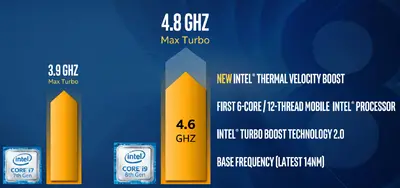(TVB) |
|||
| Line 1: | Line 1: | ||
{{intel title|Thermal Velocity Boost (TVB)}} | {{intel title|Thermal Velocity Boost (TVB)}} | ||
'''Thermal Velocity Boost''' ('''TVB''') is a microprocessor technology developed by [[Intel]] that attempts to enable temporary higher performance on top of {{intel|Turbo Boost Technology}} by opportunistically and automatically increasing the processor's clock frequency. | '''Thermal Velocity Boost''' ('''TVB''') is a microprocessor technology developed by [[Intel]] that attempts to enable temporary higher performance on top of {{intel|Turbo Boost Technology}} by opportunistically and automatically increasing the processor's clock frequency. | ||
| + | |||
| + | == Overview == | ||
| + | [[File:intel turbo velocity boost.png|right|400px]] | ||
| + | For devices with premium cooling solutions, microprocessors with {{intel|Turbo Boost}} support and TVB support enabled, the processor can automatically increase the clock frequency by up to an additional 200 MHz if the T<sub>CASE</sub> is at 50°C or lower and turbo power budget is available. Though unlikely to be sustainable and will drop once the temperature threshold is exceeded, for highly bursty workloads (such as what impacts the user experience the most), the performance increase can be fairly significant. | ||
| + | |||
| + | == History == | ||
| + | TVB was introduced with {{intel|Coffee Lake H|l=core}} parts. | ||
[[Category:power management mechanisms by intel]] | [[Category:power management mechanisms by intel]] | ||
Revision as of 22:36, 3 April 2018
Thermal Velocity Boost (TVB) is a microprocessor technology developed by Intel that attempts to enable temporary higher performance on top of Turbo Boost Technology by opportunistically and automatically increasing the processor's clock frequency.
Overview
For devices with premium cooling solutions, microprocessors with Turbo Boost support and TVB support enabled, the processor can automatically increase the clock frequency by up to an additional 200 MHz if the TCASE is at 50°C or lower and turbo power budget is available. Though unlikely to be sustainable and will drop once the temperature threshold is exceeded, for highly bursty workloads (such as what impacts the user experience the most), the performance increase can be fairly significant.
History
TVB was introduced with Coffee Lake H parts.
